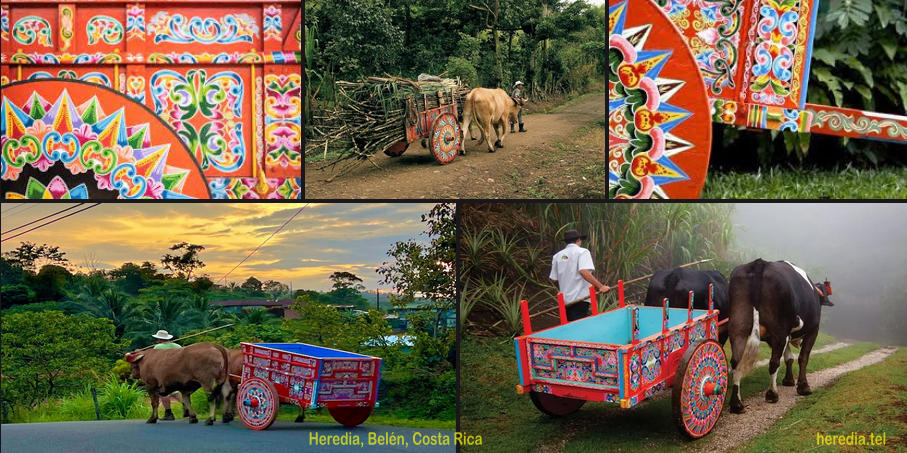
|
In 1613 San Bartolomé de Barva was erected, but in 1824, the neighbors decided to change the saint and it was erected as Asunción de Barva. The 1888 earthquake left the church in ruins. Curiously, the image of the Assumption was turned on its back on its altar and that of Saint Bartholomew remained upright, on the ruins and the neighbors considered it in a "protective attitude." Since then, the San Bartolomé festivities are very brilliant with their traditional nightly dance until reveille with people in a festive atmosphere in the streets with Creole music where fun happily reigns.
Barva is the birthplace of artists and craftsmen famous for its colonial heritage.
+
Barva is the birthplace of artists and craftsmen famous for its colonial heritage.
+

|
It is important to note that each cart had its own sound given the woods
used by carpenters in the construction of wheels. In 1978, Doña Emilia Prieto, writer and artist of vernacular singing and who was a resident of Guararí de Heredia, in one of her works stated that "there were, and are not, two identical painted carts. Special attention was paid to the painted geometry on the wheel. It was a pleasure to listen to the sounds of those carts when two or three were heading together.
When the day is no longer a day
and the night has not yet come
-blurred profiles,
blue sky with tremulous lights-
along the routes of the dream
the carts are rolling.
Julián Marchena wrote
And Aquileo J. Echeverría, remembering a popular saying about mysteries and ghosts, wrote:
"Suddenly a screeching sound was heard
I started to stop my ear
and I saw that on the way
"There was only one cart walking."
Also in the last century Domitilo Abarca wrote:
I'm going to sell my oxen:
my oxen so tame,
very good team;
little oxen like this
that goes so that never
I will find others again
throughout the earth.
And José Antonio Gutiérrez with Olegario, the name of the radio and television personality in the mid and late 20th century, made love comparisons like the one he said;
"Just like my oxes yoke
united by the yoke of a great love,
we pull the cart of illusions...
till die.
+
When the day is no longer a day
and the night has not yet come
-blurred profiles,
blue sky with tremulous lights-
along the routes of the dream
the carts are rolling.
Julián Marchena wrote
And Aquileo J. Echeverría, remembering a popular saying about mysteries and ghosts, wrote:
"Suddenly a screeching sound was heard
I started to stop my ear
and I saw that on the way
"There was only one cart walking."
Also in the last century Domitilo Abarca wrote:
I'm going to sell my oxen:
my oxen so tame,
very good team;
little oxen like this
that goes so that never
I will find others again
throughout the earth.
And José Antonio Gutiérrez with Olegario, the name of the radio and television personality in the mid and late 20th century, made love comparisons like the one he said;
"Just like my oxes yoke
united by the yoke of a great love,
we pull the cart of illusions...
till die.
+

|
Among the beauties of the place are
the old houses and its granite church.
+
+

|
This was the land of the Indian chief Cacique Yorustí. Church
It dates back to 1895. This city seems to be embedded in the Cordillera
Central Volcanic, near Cerro Zurquí. This hill has a tunnel through which the road passes
that connects the City of San José with the City of Puerto Limón in the Caribbean Sea.
+
+

|
Later, the migratory movement was greater, not only did people come in order to have their own large farm for agriculture and livestock, but hundreds of families also arrived in search of work. They arrived from the Atlantic zone and the South zone; as well as from Guanacaste, the Central Valley and from areas beyond San Carlos, pinning their hopes on a new employment opportunity, a hard job that would bring them a stable, secure income.
Over time, communication routes and public services improved; The State invested in schools and cement to build; The only thing that was needed, according to popular saying, was more people for labor. With dairy farming, the economic boom was evident, so word spread that the area was promising and the migration was supported by relatives and people known to those who already lived there. Given such evidence, Sarapiquí is a melting pot of cultures. Tourists find families with Guanacaste roots who prepare exquisite chicheme in the vicinity of northern families with excellent recipes for preparing chicharrones, or Caribbean families with their original recipe for rice and beans. Everything comes together, and in the festivals the variety is obvious with its theater groups and committees concerned with music as a sociocultural expression, crafts, plastic arts, and organization.
+
Over time, communication routes and public services improved; The State invested in schools and cement to build; The only thing that was needed, according to popular saying, was more people for labor. With dairy farming, the economic boom was evident, so word spread that the area was promising and the migration was supported by relatives and people known to those who already lived there. Given such evidence, Sarapiquí is a melting pot of cultures. Tourists find families with Guanacaste roots who prepare exquisite chicheme in the vicinity of northern families with excellent recipes for preparing chicharrones, or Caribbean families with their original recipe for rice and beans. Everything comes together, and in the festivals the variety is obvious with its theater groups and committees concerned with music as a sociocultural expression, crafts, plastic arts, and organization.
+